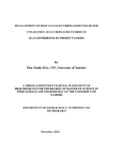| dc.description.abstract | Slaughterhouse by-product losses after slaying of animals are major problem in Kenya at present. Many slaughterhouse operators and meat traders either lack proper preservation techniques or lack technologies on how to incorporate by-products into commercial products. Value addition is one of the ways that losses can be reduced since new products can greatly improve uptake by-products. This leads to increased income for operators, improved food security, cleaner environment and more products in the market. Most of the lost by-products include blood and internal organs including offals. There is limited information about how different communities utilize various by-products despite the modern processing technological advancement. Blood has been identified as one of the most important by products after slaughter operations of food animals in Kenya. This study was therefore designed to assess how blood is utilized by different communities in the Kenyan pastoral regions with the aim of potential commercialization. The counties of Turkana, Garissa, Kajiado and Marsabit were purposively selected because they are the largest livestock producers among the pastoral Counties. Data was collected using structured questionnaires, key informant interviews and focus group discussions. Visual observations in selected slaughterhouses were also employed. The by-products that were used for food were prepared for consumption in different ways by the different communities. The utilized portions however especially that of blood was too small leading to high losses. For instance about 97% of blood in all the study areas went to waste. The study established that the by-products were not effectively utilized leading to high post slaughter wastage. The inedible by-products such as the hides were sold to tanneries, the horns were used for ornamentals, skins as dry-skin containers and hooves were just cast away.Blood was shown to be the major by-product lost in most slaughter houses and was therefore utilized in value added product development. Sausages were formulated in which fat was partially substituted with fresh bovine blood as a replacer. Fat was substituted with blood at the rate of 5% from the conventional sausage which contained 20% fat down to 0%. The sausages were evaluated for sensory properties, analysed for proximate composition, texture, cooking loss, water holding capacity, iron contents, fat oxidation as peroxide value and microbial profile and cost benefits. All the analysis for the sausages concluded that the acceptable blood/fat ratio in percentage points is 10:10. The sausages showed significant fat reductions from the full fat ones at P˂0.05, protein increased on the other hand from 14% to 15.9%. Iron increased significantly P˂0.05 from 236mg/kg to 576mg/kg with the blood increase such that a 50g sausage at10% (575.6mg/kg) replacement can supply the iron RDA for an adult man. The cooking losses, water holding capacity were not significantly affected by blood use. Use of blood as fat replacer saves the processor up to Kenya shillings 25 per kilo which translates to 9% decrease in cost of production. The sausages were also chemically stable through-out the 14 days at 18.3meq/kg for full fat sausages well below the recommended 20 meq/kg. The microbial count for the 14 day storage period showed levels that are within the KEBS standards. Salmonella spp, Listeria monocytogens, Campylobacter and Escherichia coli were all absent. The highest counts for Staphylococcus aureus, Clostridium Perfringens, and TVC were 1.16 log10cfu/g, 1.47 log10cfu/g and 5.27 log10cfu/g respectively. These were lower than the KEBS recommended values of below 6.0 log10cfu/g, 2.0 log10cfu/g and 2.0 log10cfu/g for TVC, staphylococcus aureus and Clostridium perfringens respectively. There is need to pursue other potential uses of blood and other by-products to ensure no losses occur after slaughter. | en_US |

